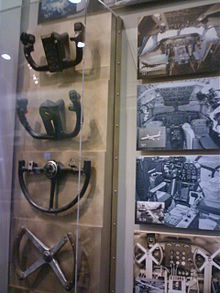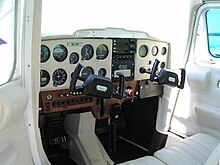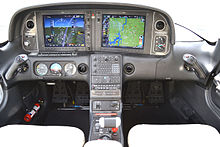Our website is made possible by displaying online advertisements to our visitors.
Please consider supporting us by disabling your ad blocker.
Yoke (aeronautics)







A yoke, alternatively known as a control wheel or a control column, is a device used for piloting some fixed-wing aircraft.[1]
The pilot uses the yoke to control the attitude of the plane, usually in both pitch and roll. Rotating the control wheel controls the ailerons and the roll axis. Fore and aft movement of the control column controls the elevator and the pitch axis.[1] When the yoke is pulled back, the nose of the aircraft rises. When the yoke is pushed forward, the nose is lowered. When the yoke is turned left, the plane rolls to the left, and when it is turned to the right, the plane rolls to the right.
Small to medium-size aircraft, usually limited to propeller-driven, feature a mechanical system whereby the yoke is connected directly to the control surfaces with cables and rods. Human muscle power alone is not enough for larger and more powerful aircraft, so hydraulic systems are used, in which yoke movements control hydraulic valves and actuators. In more modern aircraft, inputs may first be sent to a fly-by-wire system, which then sends a corresponding signal to actuators attached to the aileron booster systems and control surfaces. Yokes may feature a stick shaker, which is designed to help indicate the onset of stall, or even a stick pusher, which physically pushes the yoke to prevent a stall.
- ^ a b Crane, Dale: Dictionary of Aeronautical Terms, third edition, page 563. Aviation Supplies & Academics, 1997. ISBN 1-56027-287-2.
Previous Page Next Page


